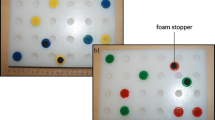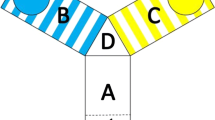Abstract
Slow–fast behavioral and life history differences have been tied to slow–fast variation in cognition that is part of the general speed-accuracy tradeoff. While there is growing evidence for such cognitive variation and its association with behavior and life history at the intraspecific level, it is unknown if a similar relationship extends to the interspecific level. Since interspecific differences in cognition have been shown to be a function of ecology and life history, such differences should be reflected in multiple traits that comprise the slow–fast cognitive axis. In this study, by measuring multiple cognitive traits in individuals, we tested for differences in the cognitive phenotype among four honeybee species, which differ in their behavior and life history in a manner that is associated with differences in their nesting ecology. Our results indicate that a set of cognitive traits consistently covary within each species, resulting in slow and fast cognitive phenotypes that largely meet the predictions of the speed-accuracy tradeoff. We also find that the four species group into two distinct clusters on a slow–fast cognitive axis, although their positions do not align with the known differences in their life history and nesting ecology. We instead find that cognitive differences among the four species are correlated with their brain size. We discuss the possible implications of these results for the role of ecology on slow–fast cognitive differences and the evolution of cognition.




Similar content being viewed by others
References
Amy M, van Oers K, Naguib M (2012) Worms under cover: relationships between performance in a learning task and personality in great.tits (Parus major). Anim Cogn 15:763–770
Bhagavan H, Brockmann A (2019) Apis florea workers show a prolonged period of nursing behavior. Apidologie 50:63–70
Bhagavan H, Muthmann O, Brockmann A (2016) Structural and temporal dynamics of the bee curtain in the open-nesting honey bee species, Apis florea. Apidologie 47:749–758
Biro PA, Stamps JA (2008) Are animal personality traits linked to life-history productivity? Trends Ecol Evol 23:361–368
Bitterman ME, Menzel R, Fietz A, Schafar S (1983) Classical conditioning of proboscis extension in honeybees (Apis mellifera). J Comp Psychol 97:107–119
Bolhuis JJ (2005) Function and mechanism in neuroecology: looking for clues. Anim Biol 55:457–490
Boogert NJ, Madden JR, Morand-Ferron J, Thornton A (2018) Measuring and understanding individual differences in cognition. Philos Trans R Soc B 373:20170280
Buechel SD, Boussard A, Kotrschal A, Wvd B, Kolm N (2018) Brain size affects performance in a reversal-learning test. Proc R Soc B Biol Sci 285:20172031
Carter AJ, Feeney WE (2012) Taking a comparative approach: Analysing personality as a multivariate behavioural response across species. PLoS ONE 7:e42440
Cauchoix M, Chaine AS (2016) How can we study the evolution of animal minds? Front Psychol 7:358–358
Chittka L, Niven J (2009) Are bigger brains better? Curr Biol 19:R995–R1008
Chittka L, Rossiter SJ, Skorupski P, Fernando C (2012) What is comparable in comparative cognition? Philos Trans R Soc B Biol Sci 367:2677–2685
Deaner RO, Isler K, Burkart JM, Schaik C (2007) Overall brain size, and not encephalization quotient, best predicts cognitive ability across non-human primates. Brain Behav Evol 70:115–124
Dukas R (2004) Evolutionary biology of animal cognition. Annu Rev Ecol Evol Syst 35:347–374
Durst C, Eichmuller S, Menzel R (1994) Development and experience lead to increased volume of the subcompartments of the honeybee mushroom body. Behav Neural Biol 62:259–263
Dyer F, Seeley T (1991) Nesting behavior and the evolution of worker tempo in four honeybee species. Ecology 72:156–170
Dyer AG, Dorin A, Reinhardt V, Garcia JE, Rosa MGP (2014) Bee reverse-learning behavior and intra-colony differences: simulations based on behavioral experiments reveal benefits of diversity. Ecol Model 277:119–131
Farris SM (2016) Insect societies and the social brain. Curr Opin Insect Sci 15:1–8
Gowda V, Gronenberg W (2019) Data from: Brain composition and scaling in social bee species differing in body size. Apidologie 50:779–792
Griffin AS, Guillette LM, Healy SD (2015) Cognition and personality: an analysis of an emerging field. Trends Ecol Evol 30:207–214
Healy SD, Bacon IE, Haggis O, Harris AP, Kelley LA (2009) Explanations for variation in cognitive ability: behavioural ecology meets comparative cognition. Behav Proc 80:288–294
Herculano-Houzel S (2011) Brains matter, bodies maybe not: the case for examining neuron numbers irrespective of body size. Ann N Y Acad Sci 1225:191–199
Kamhi JF, Gronenberg W, Robson SKA, Traniello JFA (2016) Social complexity influences brain investment and neural operation costs in ants. Proc R Soc B 283:20161949
Kaspi R, Shafir S (2013) Associative olfactory learning of the red dwarf honey bee Apis florea. Apidologie 44:100–109
Katz K, Naug D (2015) Energetic state regulates the exploration-exploitation trade-off in honeybees. Behav Ecol 26:2045–1050
Keagy J, Savard JF, Borgia G (2009) Male satin bowbird problem-solving ability predicts mating success. Anim Behav 78:809–817
Lihoreau M, Latty T, Chittka L (2012) An exploration of the social brain hypothesis in insects. Front Physiol 3:1–7
MacLean EL, Hare B, Nunn CL, Addessi E, Amici F, Anderson RC, Aureli F, Baker JM, Bania AE, Barnard AM, Boogert NJ, Call J, Cantlon JF, Cheke LG, Clayton NS, Delgado MM, DiVincenti LJ, Fujita K, Herrmann E, Hiramatsu C, Jacobs LF, Jordan KE, Laude JR, Leimgruber KL, Messer EJE, de Moura AC, Ostojić L, Picard A, Platt ML, Plotnik JM, Range F, Reader SR, Reddy RB, Sandel AA, Santos LR, Schumann K, Seed AM, Sewall KB, Shaw RC, Slocombe KE, Su Y, Takimoto A, Tan J, Tao R, van Schaik CP, Virányi Z, Visalberghi E, Wade JC, Watanabe A, Widness J, Young JK, Zentall TR, Zhao Y (2014) The evolution of self-control. Proc Natl Acad Sci USA 111:E2140–E2148
Macphail EM, Bolhuis JJ (2001) The evolution of intelligence: adaptive specializations versus general process. Biol Rev 76:341–364
Mayack C, Naug D (2011) A changing but not an absolute energy budget dictates risk-sensitive behaviour in the honeybee. Anim Behav 82:595–600
Mazza V, Eccard J, Zaccaroni M, Jacob J, Dammhahn M (2018) The fast the flexible: cognitive style drives individual variation in cognition in a small mammal. Anim Behav 137:119–132
Menzel R (2012) The honeybee as a model for understanding the basis of cognition. Nat Rev Neurosci 13:758–768
Morand-Ferron J, Quinn JL (2015) The evolution of cognition in natural populations. Trends Cogn Sci 19:235–237
Mugel SG, Naug D (2020) Metabolic rate shapes phenotypic covariance among physiological, behavioral, and life-history traits in honeybees. Behav Ecol Sociobiol 74:129
Page RE, Scheiner R, Erber J, Amdam GV (2006) The development and evolution of labor and foraging specialization in a social insect (Apis mellifera L.). Curr Topics Dev Biol 74:235–286
Reader SM, Laland KN (2002) Social intelligence, innovation, and enhanced brain size in primates. Proc Natl Acad Sci USA 99:4436–4441
Réale D, Garant D, Humphries M, Bergeron P, Careau V, Montiglio P (2010) Personality and the emergence of the pace-of-life syndrome concept at the population level. Philos Trans R Soc 365:4051–4063
Rosati AG (2017) Foraging cognition: reviving the ecological intelligence hypothesis. Trends Cogn Sci 21:691–702
Roth TC, Pravosudov VV (2009) Tough times call for bigger brains. Commun Integr Biol 2:236–238
Roth TC, LaDage LD, Pravosudov VV (2010) Learning capabilities enhanced in harsh environments: a common garden approach. Proc R Soc B Biol Sci 277:3187–3193
Seeley T (1982) Honeybee ecology. Princeton University Press, Princeton
Shafir S, Wiegmann DD, Smith BH, Real LA (1999) Risk-sensitive foraging: choice behaviors of honeybees in response to variability in volume of reward. Anim Behav 57:1055–1061
Sherry DF, Jacobs LF, Gaulin SJC (1992) Spatial memory and adaptive specialization of the hippocampus. Trends Neurosci 15:298–303
Sih A, Del Giudice M (2012) Linking behavioral syndromes and cognition: a behavioral ecology perspective. Philos Trans R Soc 367:2762–2772
Smith KE, Raine NE (2014) A comparison of visual and olfactory learning performance in the bumblebee, Bombus terrestris. Behav Ecol Sociobiol 68:1549–1559
Tait C, Naug D (2020) Cognitive phenotypes and their functional differences in the honeybee, Apis mellifera. Anim Behav 165:117–122
Tait C, Mattise-Lorenzen A, Lark A, Naug D (2019) Interindividual vairition in learning ability in honeybees. Behav Proc 167:103918
Tello-Ramos MC, Branch CL, Kozlovsky DY, Pitera AM, Pravosudov VV (2019) Spatial memory and cognitive flexibility trade-offs: to be or not to be flexible, that is the question. Anim Behav 147:129–136
Thornton A, Lukas D (2012) Individual variation in cognitive performance: developmental and evolutionary perspectives. Philos Trans R Soc B 367:2773–2783
Wang Z, Tan K (2014) Comparative analysis of olfactory learning of Apis cerana and Apis mellifera. Apidologie 45:45–52
Acknowledgements
The authors would like to thank Vishwas Gowda and Wulfila Gronenberg for generously allowing us to re-analyze their brain volume data on the different species of honeybees and Stephen Mugel for discussions.
Funding
This study was supported by funding from awards to CT from the Graduate Degree Program in Ecology, Colorado State University and the Indo-USA. 21st Century Knowledge Initiative Grant awarded to Barry Noon and awards to DN from the Dean of the College of Natural Sciences, Colorado State University, Foundation for Food and Agricultural Research and the National Science Foundation, USA.
Author information
Authors and Affiliations
Contributions
DN and CT designed the study and wrote the manuscript, CT collected and analyzed the data and AB provided funding, logistical and infrastructure support for the research conducted in Bangalore, India.
Corresponding author
Ethics declarations
Conflict of interest
The authors declare no competing or financial interests.
Ethical approval
All applicable international, national, and institutional guidelines for the care and use of animals were followed.
Additional information
Publisher's Note
Springer Nature remains neutral with regard to jurisdictional claims in published maps and institutional affiliations.
Supplementary Information
Below is the link to the electronic supplementary material.
Rights and permissions
About this article
Cite this article
Tait, C., Brockmann, A. & Naug, D. Nesting ecology does not explain slow–fast cognitive differences among honeybee species. Anim Cogn 24, 1227–1235 (2021). https://doi.org/10.1007/s10071-021-01515-2
Received:
Revised:
Accepted:
Published:
Issue Date:
DOI: https://doi.org/10.1007/s10071-021-01515-2




